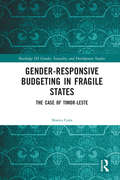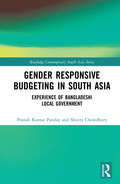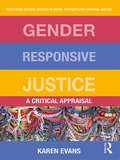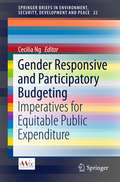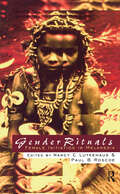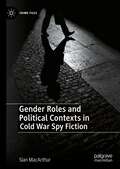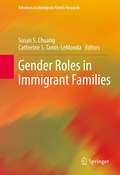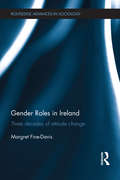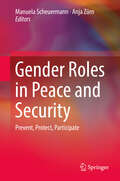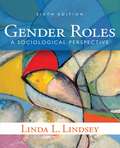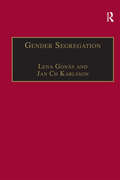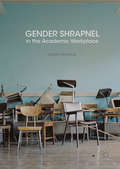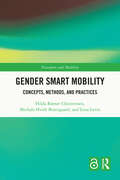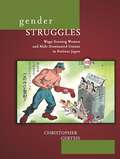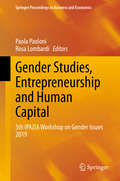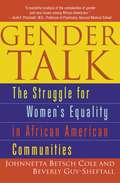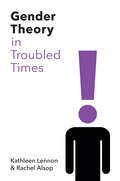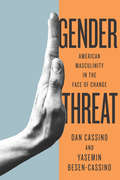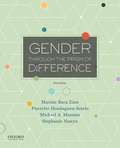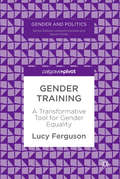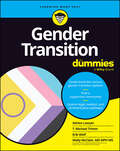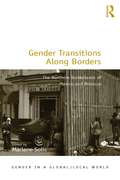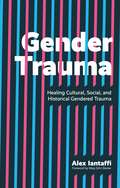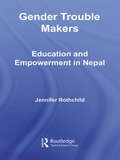- Table View
- List View
Gender Responsive Budgeting in Fragile States: The Case of Timor-Leste (Routledge ISS Gender, Sexuality and Development Studies)
by Monica CostaA growing number of governments have made commitments to achieving gender equality and women's rights, with many using gender responsive budgeting (GRB) to allocate resources for the delivery of economic policy and governance that benefit men and women equally. At a time when GRB is growing in global traction, this book investigates what it can deliver for gender equality and state resilience in contexts where the state is weak or prone to violence, such as in Timor-Leste. Gender-Responsive Budgeting in Fragile States: The Case of Timor-Leste uses the Timor-Leste case to investigate whether gender equality reform can be adopted at the same time as establishing economic and institutional fundamentals. While some may have thought that the adoption of GRB strategy in 2008 was premature, Monica Costa argues that GRB initiatives have contributed to budget accountability and transparency, and ultimately improved policy and budget processes and decisions. This multi-disciplinary analysis of a decade of GRB demonstrates why GRB is important to inform the debate on state fragility-resilience and argues that fragile states cannot defer gender equality in the name of getting the economic and institutional basics right. While a growing number of fragile states have taken steps to make their budget more gender responsive, questions remain for economists and policy makers about what can be achieved, and how. Gender Responsive Budgeting in Fragile States is the first international publication on GRB in fragile state contexts and will be of interest to researchers, upper level students, policy makers and NGOs with an interest in policy, economics, gender and development.
Gender Responsive Budgeting in South Asia: Experience of Bangladeshi Local Government (Routledge Contemporary South Asia Series)
by Pranab Kumar Panday Shuvra ChowdhuryThis book analyzes the practice of local-level participatory planning and budgeting and its impact on gender responsive budgeting (GRB) in Bangladesh. The book offers a conceptual framework that brings into focus the contribution of successful participatory budgeting practice to ensure GRB – the examination of whether men and women fall under existing income and expenditure patterns differently. It suggests that the ideas of participatory budgeting and GRB should be evolving together to provide a concrete idea to address gender needs. The book provides a theoretical explanation that contributes to the consolidation of the practice of GRB at the local government level through participatory budgeting. Conceptualizing the process of participatory budgeting and GRB in the context of Bangladesh, the book will be of interest to researchers in the field of Development Studies, Political Science, Public Administration, and Gender, as well as Asian Studies, in particular, South Asian Studies.
Gender Responsive Justice: A Critical Appraisal
by Karen EvansAt the end of the twentieth century a step-change in thinking about the offending behaviour of women began to impact on policy-makers concerned with the treatment of female offenders. A growing number of nations, states and organisations both national and supra-national in nature began to acknowledge that existing criminal justice and especially penal practices had not been sufficiently attentive to women’s needs and had discriminated against women as a result. The concept of ‘gender-responsive justice’ – an orientation to working with women and girls based around a consideration of the special needs of women as prisoners and their particular pathways to offending – has been developed as a result. This book explores the development of this concept, the theories which have informed it, policy arenas in which gender-responsive justice has been attempted and the practices of gender-responsive justice which have subsequently emerged. This book takes a global perspective as it outlines the different international and national arenas within which gender-responsive justice gained favour and considers what has been learned from this novel and feminist-inspired approach. Gender-responsive justice has not been without its critics, however, and this book also examines the different arguments which have been used to attack or critique the concept from varied perspectives. This book lays down a clear theoretical framework for understanding gender-responsive justice and will be useful in assessing current and future policy-making in this area.
Gender Responsive and Participatory Budgeting: Imperatives for Equitable Public Expenditure (SpringerBriefs in Environment, Security, Development and Peace #22)
by Cecilia NgThis unique book focuses on the hybridization of grassroots participation in planning, implementing, and developing gender-responsive budgeting. It explores the possibilities for gender sensitive budgeting when implemented using techniques that have been popularized by participatory governance activists. A combination of the two allows for a whole new way of ensuring public budgets are used equitably.
Gender Revolution: How Electoral Politics and #MeToo are Reshaping Everyday Life
by Pamela Aronson Matthew R. FlemingGender Revolution carefully examines the profound transformations happening in both public and private arenas of gender relations. It also draws critical attention to the simultaneous and potent challenges that have risen in response. The authors look to large-scale phenomena in this contemporary study and address how electoral politics and the #MeToo movement are reshaping everyday life. This gender revolution has led to a culture in which women, and increasing numbers of men, refuse to accept traditional gender norms and gender inequalities. People of all genders no longer tolerate abuses of power in politics or in their interpersonal relationships. Despite vigorous resistance, women are seizing power and refusing to back down, in ways both large and small. The authors note on the one hand that people of all genders in support of these transformations are voting for progressive candidates, engaging on social media, and making their interpersonal relationships more equal. On the other hand, they document considerable backlash and contestation, as some people are resisting these changes and creating adversarial gender divisions. Probing across these issues, the book develops an analysis of gendered social and cultural change that reveals how movement ideas diffuse into broader culture. Gender Revolution presents a vibrant and essential study for a moment marked by significant changes to attitudes, beliefs, and views surrounding gender and gender relations and will appeal to readers interested in the scholarly study of gender, society, politics, media, law, and culture.
Gender Rituals: Female Initiation in Melanesia
by Nancy C. Lutkehaus Paul B. RoscoeThis volume draws together ethnographies of female initiation rites in Melanesia which require anthropologists to rethink their analysis of initiations and their perceptions of gender. The contributors argue that female initiation rites express more than cultural notions of femininity, narrow definitions of reproduction, or coming of age rituals - instead they play an important role in other life cycle rituals and in the political and economic organization of society.
Gender Roles and Political Contexts in Cold War Spy Fiction (Crime Files)
by Sian MacArthurThis book analyses the gender roles and political contexts of spy fiction narratives published during the years of the Cold War. It offers an introduction to the development of spy fiction both in England and in the United States and explores the ways in which issues such as the atomic bomb, double agents, paranoia, propaganda and megalomania manifest themselves within the genre. The book examines the ongoing marginalization of women within spy fiction texts, exploring the idea that this unique period in global history is responsible for the active promotion and celebration of masculinity and male superiority. From James Bond to Jason Bourne, the book evaluates the ongoing enforcement of patriarchal ideas and oppressions that, in the name of national security and patriotic duty, have contributed to the development of a genre in which discrimination and bias continue to dominate.
Gender Roles in Immigrant Families
by Susan S. Chuang Catherine S. Tamis-LeMondaResearchers recognize that theoretical frameworks and models of child development and family dynamics have historically overlooked the ways in which developmental processes are shaped by socio-cultural contexts. Ecological and acculturation frameworks are especially central to understanding the experiences of immigrant populations, and current research has yielded new conceptual and methodological tools for documenting the cultural and developmental processes of children and their families. Within this broad arena, a question of central importance is on how gender roles in immigrant families play out in the lives of children and families. Gender Roles in Immigrant Families places gender at the forefront of the research by investigating how it interplays with parental roles, parent-child relationships, and child outcomes.
Gender Roles in Ireland: Three Decades of Attitude Change (Routledge Advances in Sociology)
by Margret Fine-DavisGender Roles in Ireland: three decades of attitude change documents changing attitudes toward the role of women in Ireland from 1975 to 2005, a key period of social change in this society. The book presents replicated measures from four separate surveys carried out over three decades. These cover a wide range of gender role attitudes as well as key social issues concerning the role of women in Ireland, including equal pay, equal employment opportunity, maternal employment, contraception etc. Attitudes to abortion, divorce and moral issues are also presented and discussed in the context of people’s voting behaviour in national referenda. Taken together, the data available in these studies paint a detailed and complex picture of the evolving role of women in Ireland during a period of rapid social change and key developments in social legislation. The book brings the results up to the present by including new data on current gender role issues from Margret Fine-Davis' latest research.
Gender Roles in Peace and Security: Prevent, Protect, Participate
by Manuela Scheuermann Anja ZürnThis volume examines the specific gender roles in peace and security. The authors analyse the implementation process of United Nations Security Council Resolution 1325 in various countries and discuss systemic challenges concerning the Women, Peace and Security agenda. Through in-depth case studies, the authors shed new light on topics such as the gender-related mechanisms of peace processes, gender training practices for police personnel, and the importance of violence prevention. The volume studies the role of women in peace and security as well as questions of gender mainstreaming by adopting various theoretical concepts, including feminist theories, concepts of masculinity, organizational and security studies. It also highlights regional and transnational approaches for the implementation of the Women, Peace and Security agenda, namely the perspectives of the European Union, NATO, the UN bureaucracy and the civil society. It presents best cases and political advice for tackling the problem of gender inequality in peace and security.
Gender Roles: A Sociological Perspective
by Linda L LindseyOffers a sociological perspective of gender that can be applied to our lives. Focusing on the most recent research and theory–both in the U.S. and globally–Gender Roles, 6e provides an in-depth, survey and analysis of modern gender roles and issues from a sociological perspective. The text integrates insights and research from other disciplines such as biology, psychology, anthropology, and history to help build more robust theories of gender roles.
Gender Segregation: Divisions of Work in Post-Industrial Welfare States
by Jan Ch Karlsson Lena GonäsThis insightful volume asks if, and to what extent, gender divisions in working life are changing. The contributors discuss the implications from a labour market perspective and a family-work level perspective, which are combined to examine if and where patterns of gender integration can be found. Research from several European countries is presented, as well as from the US, to provide comparative and international perspectives. A wide range of related issues are tackled including questions of methodology and measurement, as well as segregation patterns, welfare state provisions and the use of parental leave. The volume provides suggestions for integration at different levels of society and, by applying a multidisciplinary approach and illustrating developments on different analytical levels, the authors further the discussion on how integration can be pursued.
Gender Shrapnel in the Academic Workplace
by Ellen MayockThis book employs the image of "shrapnel," bits of scattered metal that can hit purposeful targets or unwitting bystanders, to narrate the story of workplace power and gender discrimination. The project interweaves stories of gender shrapnel with an examination of national rhetoric surrounding business, education, and law to uncover underlying phenomena that contribute to discourse on privilege and gender in the academic workplace. Using concrete examples that serve as case studies for subsequent discussion of data about women in the workforce, language use and misuse, sexual harassment, silence and shutting up, and hiring, training, promotion, and the glass ceiling, Mayock explores the deeper implications of gender inequity in the workplace.
Gender Smart Mobility: Concepts, Methods, and Practices (Transport and Mobility)
by Hilda Rømer Christensen Lena Levin Michala Hvidt BreengaardThis book presents gender and diversity in smart transport as a cutting-edge issue in urban contexts around the globe. It addresses new challenges and possibilities related to the smart transport sector. It demonstrates how gender and diversity are entangled in concepts and various forms of current smart mobility practices in policy, planning, and innovation. Gender Smart Mobility is presented as a game changer for future transport planning and mobility practices and how smart mobility technologies and practices might be created as a common good for all. The readers are presented with fresh approaches ranging from intersectional and visual analysis of smart mobility, gender scripts and language, to gendered innovation of design and planning. Moreover, the readers will encounter engaging boxed features which present historical, cross-cultural, and methodological examples and pose questions for critical thinking. This book meets a need for a systematic, accessible, and practical introduction and is of interest to city planners, transport providers, and politicians as well as the general public. It will also be a valuable reference for graduate and postgraduate students at technical universities, schools of architecture and planning, and for students and faculties in the social sciences, humanities, and IT and design studies. The Open Access version of this book, available at www.taylorfrancis.com, has been made available under a Creative Commons Attribution-NonCommercial-NoDerivatives 4.0 International license. Funded by the University of Copenhagen and the Swedish National Road and Transport Research Institute.
Gender Struggles: Wage-Earning Women and Male-Dominated Unions in Postwar Japan (Harvard East Asian Monographs #321)
by Christopher GerteisIn the formative years of the Japanese labor movement after World War II, the socialist unions affiliated with the General Council of Trade Unions (the labor federation known colloquially as Sohyo) formally endorsed the principles of women’s equality in the workforce and put in place measures to promote women’s active participation in union activities. However, union leaders did not embrace the legal framework for gender equality mandated by their American occupiers; rather, they pressured thousands of women labor activists to assume supportive roles that privileged a male-centered social agenda. By the late 1950s, even Japan’s radical socialist unions had reestablished the primacy of conservative gender norms, channeling women’s labor activism to support political campaigns that advantaged a male-headed household and that relegated women’s wage-earning value to the periphery of the household economy.By showing how unions raised the wages of male workers in part by transforming working-class women into middle-class housewives, Christopher Gerteis demonstrates that organized labor’s discourse on womanhood not only undermined women’s status within the labor movement but also prevented unions from linking with the emerging woman-led, neighborhood-centered organizations that typified social movements in the 1960s—a misstep that contributed to the decline of the socialist labor movement in subsequent decades.
Gender Studies, Entrepreneurship and Human Capital: 5th IPAZIA Workshop on Gender Issues 2019 (Springer Proceedings in Business and Economics)
by Rosa Lombardi Paola PaoloniIn today’s climate, academics, professional community and policy makers all have input in critical gender issues, as well as in the entrepreneurship and human capital issues. Various gender issues are published involving many scientific fields, including business, management and accounting research. Presenting the topic of gender issues, entrepreneurship and human capital, this book collects the main output of the researches presented at the Annual Workshop of IPAZIA 2019 of Rome in Italy. The authors provide a renewed and fruitful analysis of these topics, with the purpose of advancing the gender theories in the international context.
Gender Talk: The Struggle For Women's Equality in African American Communities
by Beverly Guy-Sheftall Johnnetta B. ColeWhy has the African American community remained silent about gender even as race has moved to the forefront of our nation's consciousness? In this important new book, two of the nation's leading African American intellectuals offer a resounding and far-reaching answer to a question that has been ignored for far too long. Hard-hitting and brilliant in its analysis of culture and sexual politics, Gender Talk asserts boldly that gender matters are critical to the Black community in the twenty-first century. In the Black community, rape, violence against women, and sexual harassment are as much the legacy of slavery as is racism. Johnnetta Betsch Cole and Beverly Guy-Sheftall argue powerfully that the only way to defeat this legacy is to focus on the intersection of race and gender. Gender Talk examines why the "race problem" has become so male-centered and how this has opened a deep divide between Black women and men. The authors turn to their own lives, offering intimate accounts of their experiences as daughters, wives, and leaders. They examine pivotal moments in African American history when race and gender issues collided with explosive results--from the struggle for women's suffrage in the nineteenth century to women's attempts to gain a voice in the Black Baptist movement and on into the 1960s, when the Civil Rights movement and the upsurge of Black Power transformed the Black community while sidelining women. Along the way, they present the testimonies of a large and influential group of Black women and men, including bell hooks, Faye Wattleton, Byllye Avery, Cornell West, Robin DG Kelley, Michael Eric Dyson, Marcia Gillispie, and Dorothy Height.Provding searching analysis into the present, Cole and Guy-Sheftall uncover the cultural assumptions and attitudes in hip-hop and rap, in the O.J. Simpson and Mike Tyson trials, in the Million Men and Million Women Marches, and in the battle over Clarence Thomas's appointment to the Supreme Court. Fearless and eye-opening, Gender Talk is required reading for anyone concerned with the future of African American women--and men.From the Hardcover edition.
Gender Theory in Troubled Times
by Kathleen Lennon Rachel AlsopTheorizing gender is more urgent and highly political than ever before. These are times, in many countries, of increased visibility of women in public life and high-profile campaigns against sexual violence and harassment. Challenges to fixed, traditional gender norms have paved the way for the recognition of gay marriage and gender recognition acts allowing people to change the gender assigned to them at birth. Yet these are also times of religious and political backlash by the alt right, the demonization of the very term ‘gender’ and a renewed embrace of the ‘naturalness’ of gendered difference as ordained by God or Science. A follow-up to the authors’ 2002 text, Theorizing Gender, this timely and necessary intervention revisits gender theory for contemporary times. Refusing a singular ‘truth about gender’, the authors explore the multiple strands which go into making our gendered identities, in the context of materialist and intersectional perspectives interwoven with phenomenological and performative ones. The resulting critical overview will be a welcome and invaluable guide for students and scholars of gender across the social sciences and humanities.
Gender Threat: American Masculinity in the Face of Change (Inequalities)
by Yasemin Besen-Cassino Yasemin CassinoAgainst all evidence to the contrary, American men have come to believe that the world is tilted – economically, socially, politically – against them. A majority of men across the political spectrum feel that they face some amount of discrimination because of their sex. The authors of Gender Threat look at what reasoning lies behind their belief and how they respond to it. Many feel that there is a limited set of socially accepted ways for men to express their gender identity, and when circumstances make it difficult or impossible for them to do so, they search for another outlet to compensate. Sometimes these behaviors are socially positive, such as placing a greater emphasis on fatherhood, but other times they can be maladaptive, as in the case of increased sexual harassment at work. These trends have emerged, notably, since the Great Recession of 2008-09. Drawing on multiple data sources, the authors find that the specter of threats to their gender identity has important implications for men's behavior. Importantly, younger men are more likely to turn to nontraditional compensatory behaviors, such as increased involvement in cooking, parenting, and community leadership, suggesting that the conception of masculinity is likely to change in the decades to come.
Gender Through The Prism Of Difference
by Maxine Baca Zinn Pierrette Hondagneu-Sotelo Michael A. Messner Stephanie NawynGender Through the Prism of Difference, Sixth Edition, adopts a global, transnational perspective on how race, class, and sexual diversity are central to the study of sex and gender. In contrast with other books in this area--which tend to focus on U.S. or European viewpoints--this wide-ranging anthology features many articles based on research done elsewhere throughout the world. Now in its sixth edition, the book features nineteen new readings covering compelling subjects like transgender identities and public policies, Native and Muslim women, policing and incarceration, the intersection of gender and immigration, gender and disabilities, and the #MeToo social movement.
Gender Training: A Transformative Tool for Gender Equality (Gender and Politics)
by Lucy FergusonThis book develops a case for feminist gender training as a catalyst for disjuncture, rupture and change. Chapter 1 traces the historical development and current contours of the field of gender training. In Chapter 2, the key critiques of gender training are substantively engaged with from the perspective of reflexive practice, highlighting the need to work strategically within existing constraints. Questions of transformative change are addressed in Chapter 3, which reviews feminist approaches to change and how these can be applied to enhance the impact of gender training. Chapter 4 considers the theory and practice of feminist pedagogies in gender training. In the final chapter, new avenues for gender training are explored: working with privilege; engaging with applied theatre; and mindfulness/meditation. The study takes gender training beyond its often technocratic form towards a creative, liberating process with the potential to evoke tangible, lasting transformation for gender equality.
Gender Transition For Dummies
by Molly McClain Erik Wolf Adrien Lawyer T. Michael TrimmGender transition is different for everyone—get the support you need for your unique journey Gender Transition For Dummies is an essential resource for transgender and non-binary readers who are considering the various elements of what is often called gender transition. It starts at the beginning, answering questions like, “What is transgender and what is non-binary?” and, “How Do I Know If I'm Transgender?” Learn to navigate social transition, prepare for gender-affirming surgery, tell loved ones about your transition plans, find a supportive community, and take care of your mental health. Undertaking any of these steps is a big decision, and it isn't always easy. With this Dummies guide, you'll know that you aren't alone, and you'll get tips from experts on advocating for yourself. Manage gender dysphoria, find supportive care providers, and protect your mental health Know what to expect with hormone therapy and gender-affirming surgery Learn how to change your legal documents and ask people to use the name and pronouns that feel right for you Gender Transition For Dummies is here to support and guide the transgender and gender-diverse community—and their loved ones—and help them to thrive.
Gender Transitions Along Borders: The Northern Borderlands of Mexico and Morocco (Gender in a Global/Local World)
by Marlene SolisIn recent decades, women living in border cities have taken on new roles and have become one of the most vulnerable population groups; experiencing the effects of the economic crisis of the early 21st century and the consequent increase in social inequality and violence. This situation is particularly evident for the northern borderlands of Mexico and Morocco. The geopolitical position of these regions is defined by their strong existing asymmetry with their neighbouring countries: the United States, in the case of Mexico, and the Mediterranean European countries, in the case of Morocco. This book contributes to the understanding of current changes in the workplace, in family, in sexuality and sexual violence within the setting of the borderlands, through various studies addressing the manner in which these transformations are interpreted and experienced by women in everyday life and in their individual and collective agency.
Gender Trauma: Healing Cultural, Social, and Historical Gendered Trauma
by Alex IantaffiExploring how the essentialism of the gender binary impacts on clients of all genders, this ground-breaking book examines how historical, social and culturally gendered trauma emerges in clinical settings. Weaving together systemic ideas, autoethnography, narrative therapy and somatic experiencing, the book charts the history of the gender binary and its roots in colonialism, as well as the way this culture is perpetuated intergenerationally, and the impact this trauma has on all bodies, gender identities and experiences.Featuring clinical vignettes, exercises and reflexive practices, this is an accessible and intersectional guide for professionals to develop their understanding of gender-derived trauma for supporting clients. Highlighting the importance of applying a trauma-informed approach in practice, this book provides insights as to how we can work towards collective healing, for future generations and for ourselves.
Gender Trouble Makers: Education and Empowerment in Nepal (New Approaches in Sociology)
by Jennifer RothchildInternational development efforts aimed at improving girls’ lives and education have been well-intended, somewhat effective, but ultimately short-sighted and incomplete. This is because international development efforts often operate under a reductive understanding of the term 'gender' and how it influences the lives of girls and boys. Gender is more commonly conceived by international efforts as characteristics which are ascribed to girls as norms for behaviour. In particular, the analysis in Gender Trouble Makers focuses on the social constructions of gender and the ways in which gender was reinforced and maintained through a case study in rural Nepal. In developing countries like Nepal, promoting access to and participation in existing formal education programme is clearly necessary, but it is not, in itself, sufficient to transform gender power relations in the broader society. When gender is properly addressed as a process, then all stakeholders involved - researchers, governmental officials, and community members - can begin to understand and devise more effective ways to increase both girl and boy students’ enrollment, participation, and success in school.
